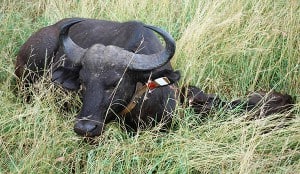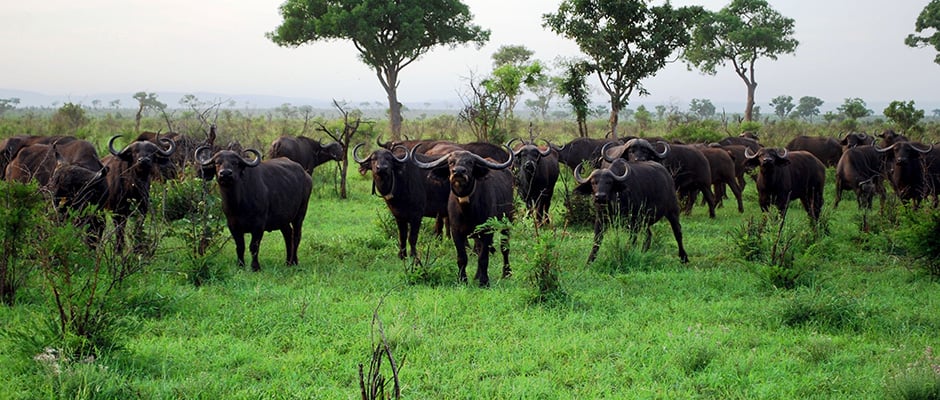Share this article
Parasite Treatment in Buffalo Could Help Spread of TB
A helicopter flew close to the ground in Krueger National Park, South Africa, executing a series of aerial acrobatics in order to steer the herd of African buffalo (Syncerus caffer) towards a good area for a park veterinarian to start shooting tranquilizer rounds.
Meanwhile, Vanessa Ezenwa, associate professor of ecology and infectious diseases at the University of Georgia, and a group of other researchers waited in a 4X4 on the ground nearby for the right moment to go in and tag the buffalo with satellite tracking devices.
“It can be highly dramatic,” Ezenwa said. But tranquilization was a relative term as it applied to the buffalo, and park technicians had to go in first, grab the animals by their thrashing horns, and hold them relatively steady while the researchers did their work.

Darting buffalo from a helicopter.
Image Credit: Vanessa Ezenwa, University of Georgia
“They’re still quite aggressive by nature. They’re feisty even though they’re darted,” she said.
Ezenwa was working on a project to test the relations between parasitic worm treatments and tuberculosis — a study that had wide-ranging implications for managing interactions between cattle and wildlife and potentially even human health and treatment strategies. The study, published today in the journal Science, found that treating the buffalo for worms could actually cause larger populations of buffalo to become infected by tuberculosis.
The line of thinking goes like this: If you treat an individual buffalo that also has tuberculosis for parasitic worms, the animal’s immune system will be stronger and allow it to survive longer with the lung disease.
While this may be good for the infected individual, Ezenwa said that it could be bad for larger populations of buffalo. “The negative side effect is that the individual who lives longer is able to spread the infection for a longer period of time.”
After initial tagging and testing operations, technicians working with her team had to go back in 4X4s with tranquilizer guns twice a year to re-catch the animals and test them for disease — a comparatively smaller operation than the initial tagging.
Her research also showed that treating uninfected buffalo for parasitic worms doesn’t make them more resistant to tuberculosis. “De-worming has no effect on an individual’s chance of getting infected.”
Bovine tuberculosis was introduced to African buffalo via cattle populations and while the buffalo aren’t endangered, Ezenwa said sustaining populations of the species is important because they contribute to the local economy through hunting and ecotourism.

A radio-collared female buffalo.
Image Credit: Vanessa Ezenwa, University of Georgia
Ezenwa also said that the study could have larger implications for understanding diseases in wildlife and disease-control strategy. She said that American bison also have common parasitic worm infections that could interact in some way with brucellosis — a disease that is currently creating hurdles for the animals’ recovery in western provinces as bison can transmit the disease to cattle.
“These worms potentially affect other things,” she said. “We have a lot of diseases that are shifting their geological regions.”
In order to look more closely at potential interactions, Ezenwa said her next study will likely look at the interactions between parasites and brucellosis among the African buffalo, which also carry the disease.
“You can translate that story to issues in the U.S.,” she said in reference to the fact that these future studies could be useful when looking at management strategies for American bison and brucellosis.
Finally, Ezenwa said the information could have an impact on the way we plan disease treatment for human populations. She said that some people have considered using parasite treatments in poorer areas where the problems are endemic as ways to reduce the overall number of people who contract HIV or tuberculosis.
“Worm drugs are relatively cheap and effective” in comparison to treating these more serious diseases, she said. But the results of her study show that using anti-parasitic treatments as a way to indirectly reduce the spread of HIV or tuberculosis may not work, and that the interaction between parasites and diseases “is more complicated than we previously thought.”
Header Image:
Radio-collared buffalo in a herd.
Image Credit: Rob Spaan, Oregon State University








